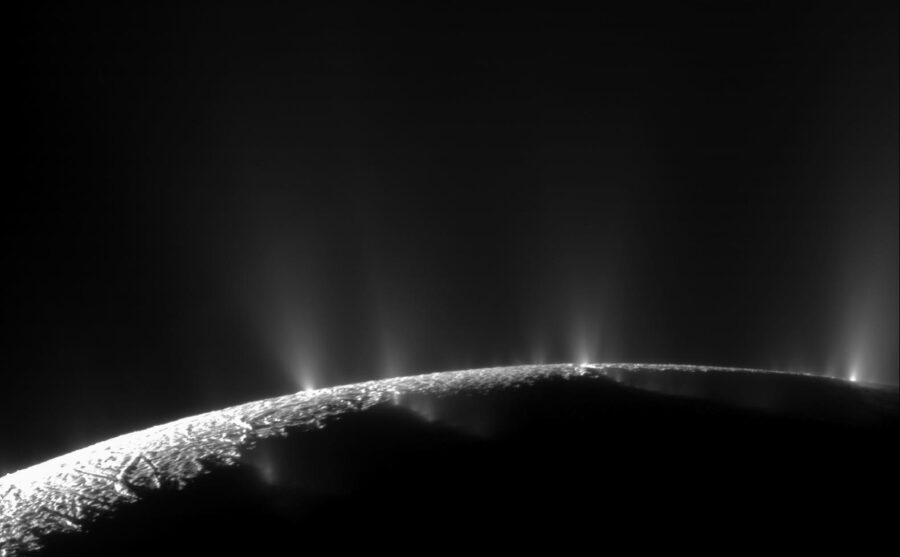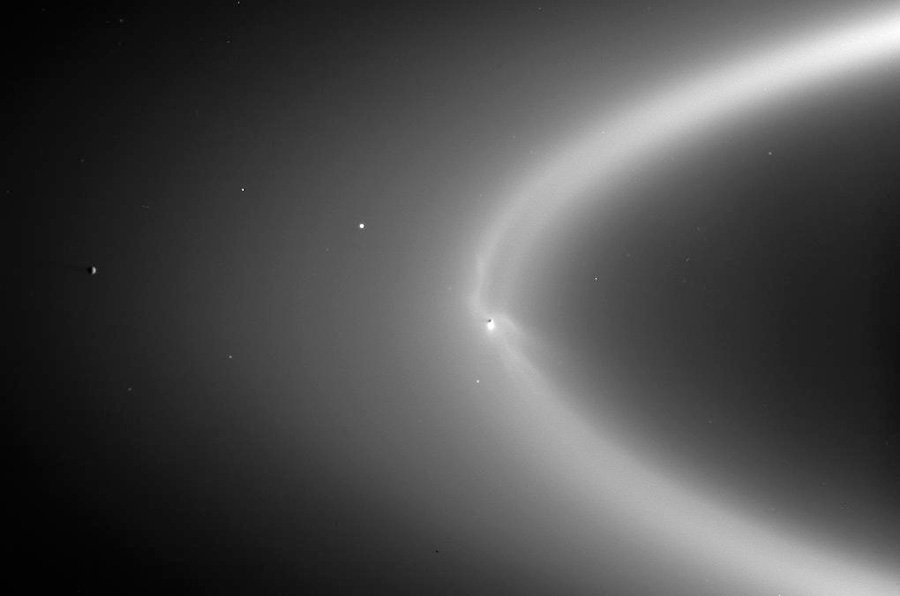Scientists have detected phosphorous in an extraterrestrial ocean for the first time.

NASA / JPL / Space Science institute
Do you remember high school biology? One thing you learned was that CHNOPS were essential for life. CHNOPS stands for six light elements essential to every known organism: carbon, hydrogen, nitrogen, oxygen, phosphorus, and sulfur. Five of these are abundant across the solar system, but phosphorus is uncommon and rarely detected. (You may recall hype about phosphine in Venus’ atmosphere.) This week, researchers announced the first detection of phosphorus in an extraterrestrial ocean.
The research, led by Frank Postberg of the Freie Universitat Berlin and published in Nature, examined publicly archived data collected by the Cosmic Dust Analyzer (CDA) aboard NASA's Cassini orbiter as it passed repeatedly through Saturn’s E ring. The E ring is a tenuous but very broad donut of material orbiting Saturn that is densest near the orbit of the moon Enceladus. Cassini data has already demonstrated that Enceladus’s south polar geysers, which originate in a sub-crustal ocean, are the source of the icy particles of the E ring.
Most of the E ring is isolated water molecules, but it contains some larger particles, too. Those larger particles are (probably) tiny frozen droplets of Enceladus’s ocean. They therefore contain not only water but also all the salts dissolved in Enceladus’s ocean water. The CDA detected these particles when they struck a rhodium metal target within the instrument at very high speed and vaporized. Positively charged ions within that vapor careened into the instrument’s electrically charged detector, which separated the ions by atomic mass and counted the number of ions of each mass.

NASA / JPL / Space Science Institute
Postberg’s research team examined 345 such particles in the CDA data archives. Nine of those particles contained significant numbers of ions with masses of 125, 165, and 187 atomic units, corresponding to different fragments of what had begun as the mineral sodium phosphate (Na3PO4). Laboratory experiments using a high-powered laser to zap a solution of sodium phosphate in water produced ions with the same masses. The phosphate in Enceladus’s ocean would come from carbonate-rich ocean water percolating through rocks, reacting with calcium phosphate (apatite) minerals to make calcium carbonate (calcite) and sodium phosphate.
It’s cool to detect a rare element, but why does it matter? The study explains that “the availability of phosphorus would be the bottleneck of bio-essential elements on Enceladus and other icy ocean worlds with potential hydrothermal activity and without dry land.” The detection of phosphate salts in the E ring means that Enceladus’s ocean “has a high availability of dissolved [phosphorus], which is thus extremely unlikely to be a limiting factor in the survival of putative life on Enceladus — and perhaps also on other ocean worlds.”
To be clear, this is not a detection of life, or anywhere near it. It is the removal of one specific concern about whether one specific world has the necessary raw materials for life. That’s the way science works, in tiny little steps; for those of us who hope to find life elsewhere, it’s a step in the right direction.
 6
6









Comments
Anthony Barreiro
June 17, 2023 at 5:55 pm
Planetary science is becoming more and more like geology and less and less like astronomy!
Phosphorus is also a limiting factor for life here on Earth. Synthetic fertilizers are various formulations of nitrogen, phosphorus, and potassium -- NPK.
You must be logged in to post a comment.
AlanF
June 24, 2023 at 10:06 am
No proof of life of course but let’s not forget that phosphate is an important part of DNA …
What a great discovery by Cassini ! Watch this space …
You must be logged in to post a comment.
AlanF
June 27, 2023 at 3:13 pm
Does the first line of this excellent article contain a spelling error? Surely the noun is phosphorus not phosphorous as written, also in some of our comments.
You must be logged in to post a comment.
Rod
June 19, 2023 at 7:50 am
I went back and reviewed Charles Darwin warm little pond found in his 1871 and 1882 letters. ref - https://www.darwinproject.ac.uk/letter/?docId=letters/DCP-LETT-7471.xml&query=warm%20little%20pond#hit.rank2
ref - https://www.darwinproject.ac.uk/letter/?docId=letters/DCP-LETT-13711.xml&query=general%20law%20of%20nature#hit.rank1
It is interesting to compare how science on the origin of life advanced so much from 1871 and 1882 letters from a warm little pond to Enceladus at Saturn. 4 things I learned about the origin of life when reading over Darwin's letters. 1. A warm little pond is postulated for the origin of life on Earth but Charles Darwin thought if abiogenesis operating in a warm little pond in his time, perhaps such life evolving from non-living matter would be quickly destroyed by existing life and eaten. 2. No good evidence for abiogenesis taking place in Charles Darwin time seen in nature. 3. The law of continuity is needed for abiogenesis to work apparently, and 4. Someday a general law of nature developed to describe and show abiogenesis like other laws of nature, for example the laws of motion or law of gravity. Apparently all four I list here are missing in science today, even with natural law operating in nature in a uniform manner, i.e., *law of continuity*. When I consider point #1, it is good IMO to avoid catastrophism that wipes out abiogenesis creating life from non-living matter at the very beginning otherwise many abiogenesis events must be envisioned to replace the earlier efforts that failed. These are four points I learned by reading some of Charles Darwin letters on the warm little pond and origin of life on Earth.
You must be logged in to post a comment.
Martian-Bachelor
June 20, 2023 at 5:31 pm
If phosphorous is both rare and a bottleneck element, then maybe its detection as a mineral is not so good news for the possibility of life inside Enceladus, as then it would all be tied up inside whatever critters there were there instead of being availabe for us to observe it. Kinda like how there isn't much carbon in our atmosphere.
You must be logged in to post a comment.
Anthony Barreiro
June 20, 2023 at 7:03 pm
9/345 = 2.6%. Commercially harvested guano, i.e. bird poop, has about 6% phosphate.
You must be logged in to post a comment.
You must be logged in to post a comment.